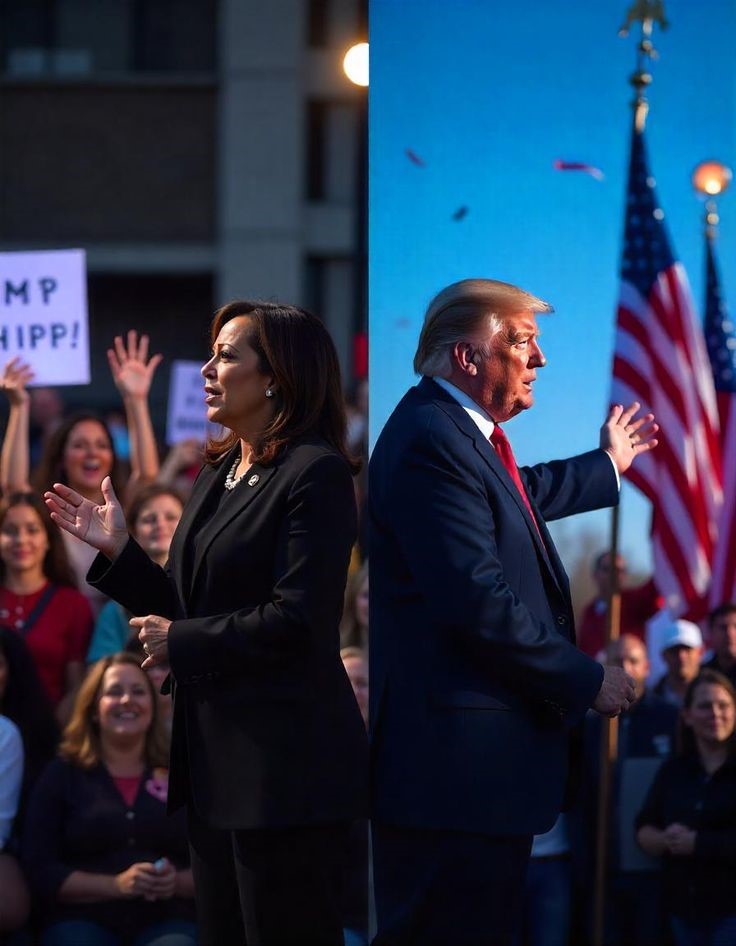
Introduction
The 2024 U.S. presidential election was one of the most significant political events in modern American history. This election saw former President Donald Trump make a comeback bid against Vice President Kamala Harris, who stepped into the Democratic nomination after President Joe Biden withdrew from the race. The campaign was characterized by heated debates, policy clashes, and a nation deeply divided on critical issues. The stakes were high as Americans cast their votes, determining the future direction of the country.
Background of the Candidates
Kamala Harris: The Democratic Nominee
Kamala Harris, the first female Vice President of the United States, was thrust into the spotlight after Joe Biden chose not to seek re-election. Harris had served as a U.S. Senator from California before becoming Biden’s running mate in 2020. Her campaign focused on continuing the policies of the Biden administration, particularly in areas such as healthcare, climate change, and social justice reforms.
Donald Trump: The Republican Comeback
Donald Trump, having lost the 2020 election to Biden, remained a dominant figure in the Republican Party. He officially launched his campaign in 2023, promising to bring back his “America First” policies. Trump’s campaign emphasized economic growth, immigration control, and a tougher stance on crime. His rallies drew large crowds, demonstrating his continued influence among conservatives.
Key Issues in the Election
Economy and Inflation
One of the major concerns for voters was the state of the economy. Inflation had affected the cost of living, and while job numbers were steady, many Americans felt that their wages were not keeping up with rising prices. Harris promised to expand economic relief programs and invest in green energy jobs, while Trump vowed to lower taxes and reduce government regulations to stimulate business growth.
Immigration Policy
Immigration remained a highly contentious issue in the election. Harris advocated for a path to citizenship for undocumented immigrants and a more humane asylum process. Trump, on the other hand, pushed for stricter border controls, including reviving policies such as “Remain in Mexico” and completing the U.S.-Mexico border wall.
Healthcare and Social Programs
Harris championed the expansion of the Affordable Care Act and proposed government intervention to lower prescription drug prices. Trump criticized the current healthcare system, promising to replace “Obamacare” with a more market-driven alternative that he claimed would lower costs and increase choices for Americans.
Foreign Policy and National Security
Foreign relations played a significant role in the campaign, especially with rising tensions with China and Russia. Harris maintained that diplomacy and strong alliances were key to maintaining global stability. Trump, on the other hand, favored a more isolationist approach, arguing that America needed to focus more on domestic issues rather than international conflicts.
Presidential Debates and Public Opinion
The presidential debates were highly anticipated events that influenced voter sentiment. Harris aimed to present herself as a steady leader, while Trump utilized his trademark aggressive debate style to appeal to his base. The debates highlighted key policy differences and solidified each candidate’s stance on major issues.
Media Influence and Polling Trends
Media coverage played a crucial role in shaping public perception of the candidates. While mainstream media outlets provided extensive analysis, social media platforms became hotbeds for political discourse, misinformation, and campaign advertising. Polling trends indicated a tight race, with different sources predicting varied outcomes.
The Election Results
On November 5, 2024, Americans cast their votes in record numbers. The election concluded with Donald Trump securing 312 electoral votes to Harris’s 226. Trump also won the popular vote, marking a historic shift in Republican electoral success.
Post-Election Reactions and Analysis
Democratic Party’s Response
The Democratic Party faced internal debates over the reasons for Harris’s defeat. Some analysts pointed to a lack of enthusiasm among young voters, while others believed that economic concerns overshadowed the party’s social policies. Calls for new leadership within the party gained momentum.
Republican Party’s Victory and Future Plans
Trump’s victory marked a major shift in American politics, as Republicans also gained control of Congress. His administration faced the challenge of uniting the country while implementing a conservative policy agenda.
Public Sentiment and National Unity
Public reaction was mixed, with Trump supporters celebrating his return while Harris’s supporters expressed disappointment and concern over the future of progressive policies. The election results emphasized the ongoing political divide in the country.
Conclusion
The 2024 presidential election between Kamala Harris and Donald Trump was a defining moment in U.S. history. While Trump’s victory signaled a shift toward conservative governance, the challenges ahead included addressing national divisions, economic recovery, and global diplomacy. As the new administration took shape, America stood at a crossroads, with its future direction dependent on the leadership choices of the coming years.






